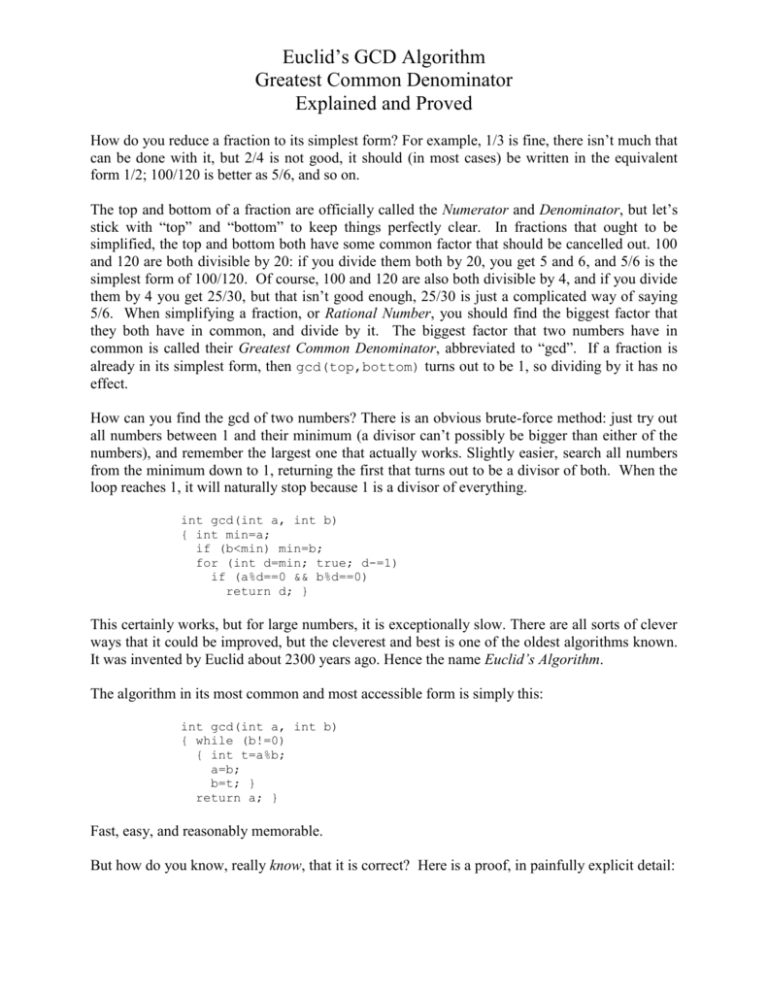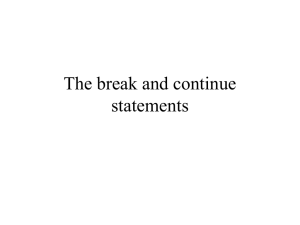gcd proof
advertisement

Euclid’s GCD Algorithm
Greatest Common Denominator
Explained and Proved
How do you reduce a fraction to its simplest form? For example, 1/3 is fine, there isn’t much that
can be done with it, but 2/4 is not good, it should (in most cases) be written in the equivalent
form 1/2; 100/120 is better as 5/6, and so on.
The top and bottom of a fraction are officially called the Numerator and Denominator, but let’s
stick with “top” and “bottom” to keep things perfectly clear. In fractions that ought to be
simplified, the top and bottom both have some common factor that should be cancelled out. 100
and 120 are both divisible by 20: if you divide them both by 20, you get 5 and 6, and 5/6 is the
simplest form of 100/120. Of course, 100 and 120 are also both divisible by 4, and if you divide
them by 4 you get 25/30, but that isn’t good enough, 25/30 is just a complicated way of saying
5/6. When simplifying a fraction, or Rational Number, you should find the biggest factor that
they both have in common, and divide by it. The biggest factor that two numbers have in
common is called their Greatest Common Denominator, abbreviated to “gcd”. If a fraction is
already in its simplest form, then gcd(top,bottom) turns out to be 1, so dividing by it has no
effect.
How can you find the gcd of two numbers? There is an obvious brute-force method: just try out
all numbers between 1 and their minimum (a divisor can’t possibly be bigger than either of the
numbers), and remember the largest one that actually works. Slightly easier, search all numbers
from the minimum down to 1, returning the first that turns out to be a divisor of both. When the
loop reaches 1, it will naturally stop because 1 is a divisor of everything.
int gcd(int a, int b)
{ int min=a;
if (b<min) min=b;
for (int d=min; true; d-=1)
if (a%d==0 && b%d==0)
return d; }
This certainly works, but for large numbers, it is exceptionally slow. There are all sorts of clever
ways that it could be improved, but the cleverest and best is one of the oldest algorithms known.
It was invented by Euclid about 2300 years ago. Hence the name Euclid’s Algorithm.
The algorithm in its most common and most accessible form is simply this:
int gcd(int a, int b)
{ while (b!=0)
{ int t=a%b;
a=b;
b=t; }
return a; }
Fast, easy, and reasonably memorable.
But how do you know, really know, that it is correct? Here is a proof, in painfully explicit detail:
The phrase “X is a divisor of B” means simply that X “goes in to” B. B can be divided by X
exactly without leaving a remainder. In C syntax, B%X==0.
If B%X==Y, that is equivalent to saying that B==N*X+Y for some N. (All numbers here are of
course integers).
So, if X is a divisor of B, and X is a divisor of C, then B%X==0 and C%X==0, which means that
B==N*X and C==M*X for some unknown (and irrelevant) integers M and N.
If B==N*X and C==M*X then B+C==(N+M)*X. As M and N were just unknown integers, then
M+N is an equally good unknown integer, so we could rewrite it as B+C==N*X for some other
unknown integer N. This means that (B+C)%X==0, which means that B+C is also divisible by
X. This gives us step 1:
1.
if
X is a divisor of B
and X is a divisor of C
then X is a divisor of B+C
and of 2B+C
and of 3B+C
and of NB+C for all N.
and of NB+2C for all N.
and of NB+3C for all N.
and of NB+MC for all M,N.
etc etc etc. Even if M,N negative.
2.
Therefore
if
X is a divisor of NB+C
and X is a divisor of B
then X is a divisor of (NB+C)-NB = C
3.
So, every divisor of B and NB+C is also a divisor of C
i.e.
every common divisor of B and NB+C
is also a common divisor of B and C
and from 1, every common divisor of B and C
is also a common divisor of B and NB+C
therefore
the set of common divisors of B and C
is the same as the set of common divisors of B and NB+C
if two sets are the same, their greatest elements must be the same.
so gcd(B, NB+C) == gcd(B, C) for all N
If A%B==C, then A == NB+C for some positive N and C, so from step 3 we know that
gcd(A,B) == gcd(C,B), and clearly C is smaller than A but still positive. so replacing
gcd(A,B) with gcd(C,B) gives the same result but has smaller arguments (getting nearer to
zero), so is a good basis for a recursive definition. gcd(A,B) is the same as gcd(A%B,B).
Everything can be divided exactly by itself, so we can always say that B is a divisor of B. so if B
is also a divisor of A, then it is a common divisor of A and B. No divisor of B can be greater than
B itself. Therefore if B is a divisor of A, then B is not only a common divisor of A and B, but also
the greatest common divisor, so whenever A%B==0, we know that gcd(A,B)==B. This gives
the base case for a recursive definition.
gcd(A,B) =
{ compute C = A%B;
// this means that A = NB+C for some positive N, C
return gcd(B,C); }
Of course, if B==0 you can't compute C=A%B. So if B==0 what are you going to do?
gcd(X,0) isn't a valid question (it is on a par with trying to divide something by zero), so it
should only arise as the result of one of the recursive calls. So catch C==0 before the recursion.
If C==0 what does it mean? B is a divisor of A, so gcd(A,B) is B. Therefore if C==0 return
B instead of going into the recursion.
gcd(A,B) =
{ C=A%B;
if (C==0)
return B;
else
return gcd(B,C); }
That can be made "safe" against accidental original calls with B==0 by moving the test to before
the % operation: if C==0 didn't get caught, we'd have the recursive call gcd(B,0, B being the
first argument to this new call, and the value that should have been returned. So if the test comes
first, it must check the second argument for zeroness and return the first:
int gcd(int A, int B)
{ if (B==0)
return A;
else
return gcd(B, A%B); }
I think this recursive version is even neater than the standard loopy one, but recursion is not free,
it requires a potentially largeish amount of stack memory, so I would still go with the loopy
equivalent.
How does this get converted to a loop? Easy. Observe that the recursive call, if it happens, is
the very last thing that the function does, so it can be seen as a jump back to the beginning with
different values for A and B. A gets replaced by B, and B gets replaced by A%B. Of course, you
can’t just do those two replacements sequentially because once A gets replaced by B, you can’t
work out A%B any more, so a temporary is required to keep it safe.
int gcd(int A, int B)
{ while (true)
{ if (B==0)
return A;
int C=A%B;
A=B;
B=C; } }
Q.E.D.








